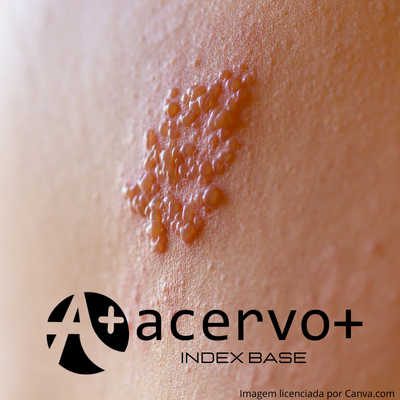Atualização clínica na infecção pela varicela zoster
##plugins.themes.bootstrap3.article.main##
Resumo
Objetivo: Realizar uma atualização clínica das principais características clínicas da infecção pelo vírus varicela zoster e suas implicações aos pacientes infectados. Métodos: Foi adotado como método a revisão integrativa da literatura realizando a triagem na base de dados PubMed e no mecanismo de busca do Google Acadêmico, utilizando descritores em Ciências da Saúde (DeCS), combinados com o erador booleano AND, “Varicela zoster” AND “Virulência” AND “Tratamento”. A partir disso, 11 artigosonstituíam corpus textual para a análise e pesquisa. Resultados: As principais características clínicas da infecção pela varicela zoster são o polimorfismo das lesões cutâneas (na pele) que se apresentam nas diversas formas evolutivas (máculas, pápulas, vesículas, pústulas e crostas), acompanhadas de prurido, a manifestação da neuralgia pós-herpética, infecções bacterianas secundárias de pele, a imunossupressão favorece formas mais graves da doença e a coinfecção com aOVID-19 pode reativar o vírus latente no organismo. Considerações finais: Afirma-se que os mais propensos a desenvolver herpes zoster são as crianças e os idosos. Já em adultos, o herpes zoster se manifesta principalmente em pessoas com o sistema imunológico abalado, HIV positivo, Diabetes Mellitus tipo 2 (DM2), estresse excessivo, câncer etre outras patologias.
##plugins.themes.bootstrap3.article.details##
Copyright © | Todos os direitos reservados.
A revista detém os direitos autorais exclusivos de publicação deste artigo nos termos da lei 9610/98.
Reprodução parcial
É livre o uso de partes do texto, figuras e questionário do artigo, sendo obrigatória a citação dos autores e revista.
Reprodução total
É expressamente proibida, devendo ser autorizada pela revista.
Referências
2. BARBOSA PPL, et al. Aspectos clínicos e epidemiológicos de pacientes internados por varicela ou herpes zoster em um hospital público de referência para doenças infecciosas em Fortaleza-CE, 2009- 2018. 2020. 92 f. Dissertação (Mestrado em Patologia) - Faculdade de Medicina, Universidade Federal do Ceará, Fortaleza, 2020.
3. BARROS MS, et al. Herpes zoster com complicações em pacientes idosos. Research, Society and Development, 2021; 10(10): e208101018654.
4. BASTOS MO, et al. Infecções oportunistas com acometimento ocular na AIDS: desafios diagnósticos. The Brazilian Journal Of Infectious Diseases, 2022; 26(S1): 101847.
5. BORGES EO, RANGEL LC. O papel do enfermeiro na identificação dos sinais e sintomas e no tratamento de enfermagem ao portador de herpes zoster. Revista Interdisciplinar Pensamento Científico, 2019; 1: 2.
6. C. JÚNIOR TGM, et al. Perfil clínico das internações por herpes zoster em um hospital universitário. Revista Hospital Universitário Pedro Ernesto, 2017; 16(2): 85-88.
7. COSTA MRM, et al. Vírus da varicela-zoster: identificação dos genótipos em casos de varicela e herpes-zoster nos municípios de ananindeua, belém e marituba, estado do pará, brasil. Revista Pan-Amazônica de Saúde, 2016; 7(3): 31-41.
8. DOMINGUEZ FILHO OJL, et al. Manifestações orais em pacientes imunodeprimidos pelo Vírus da Imunodeficiência Humana (HIV): revisão da literatura. Revista Eletrônica Acervo Saúde, 2021; 13(2): e6034.
9. EID E, et al. Surgimento de herpes zoster após vacina de mRNA COVID-19. Jornal de Virologia Médica, 2021; 93(9): 5231-5232.
10. FERNANDES HJ, et al. Neurocriptococose pós-covid com evolução pouco comum em paciente aparentemente imunocompetente: relato de caso. The Brazilian Journal Of Infectious Diseases, 2022; 26(S1): 101820.
11. FERREIRA ACAF, et al. COVID-19 and herpes zoster co-infection presenting with trigeminal neuropathy. European journal of neurology, 2020; 27(9): 1748–1750.
12. FREITAS BCB, et al. Diagnóstico e Manejo de uma complicação de Herpes zoster: um relato de caso. Revista Eletrônica Acervo Saúde, 2022; 15(8): e10749.
13. LUÍS JG e MARTINS BAC. Tratamento do herpes zoster e prevenção da nevralgia pós-herpética. Revista Portuguesa De Medicina Geral E Familiar, 2021; 37(5): 446–455.
14. MARRA F, et al. Risk Factors for Herpes Zoster Infection: A Meta-Analysis. Open forum infectious diseases, 2020; 7(1): ofaa005.
15. MOREIRA JB, et al. Ação educativa do enfermeiro na prevenção e tratamento do herpes zoster. Múltiplos Acessos, 2019; 4(2): 174-186.
16. OLIVEIRA DR, et al. Herpes zoster e tratamento. Revista Ibero-Americana de Humanidades, Ciências e Educação, 2021; 7(9): 109–122.
17. PATIL A, et al. Herpes zoster: A Review of Clinical Manifestations and Management. Viruses, 2022; 14(2): 192.
18. PORTELLA AVT, et al. Herpes-zoster e neuralgia pós-herpética. Revista Dor São Paulo, 2016; 14(3): 210-215.
19. TARTARI F, et al. Herpes zoster in COVID-19-positive patients. International journal of dermatology, 2020; 59(8): 1028–1029.
20. TONIOLO-NETO J, et al. Measuring herpes zoster disease burden in São Paulo, Brazil: a clinico-epidemiological single-center study. Clínicas, 2018; 73.

